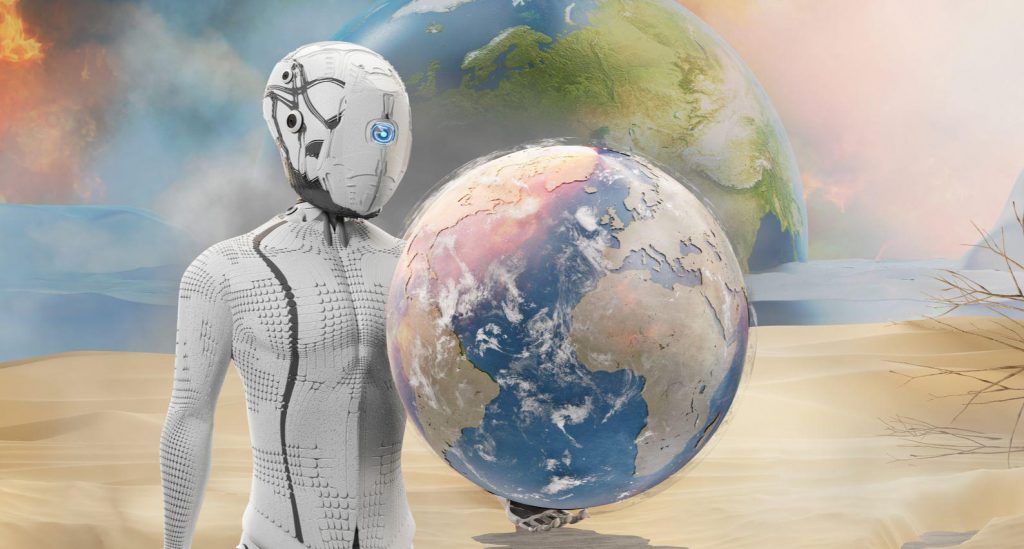
Without doubt, AI has enabled us in making a quantum leap in technological advancements and has helped in easing our lives. But on the flip side, its exponential use is also causing environmental damage
Even though Artificial Intelligence (AI) has been around for decades, by and large there was not much awareness about how deeply embedded it has become in our lives. For the common man the first perceptible brush with AI was limited to interactions with virtual assistant Siri and then its arch-rival Alexa. For the privileged children it was Pleo the Camarasaurus dinosaur that was their introduction to the world of AI in 2006. Since then, AI has taken a quantum leap.
Even though we are living in a tech-friendly world, with the young and even the elderly adapting quickly to any new tech that makes our lives easier, very few of us grasp AI’s impact.
It pervades nearly every aspect of our lives. Starting from Siri and Alexa, AI runs recommendation systems, inventory optimisation and fraud detection systems in e-commerce platforms; fraud detection, risk management and investment advice systems in financial institutions; natural language processing (NLP) for chatbots and customer service; image and facial recognition in security systems; medical diagnosis and healthcare systems; personalized content recommendations on streaming platforms; navigation apps; industrial uses like developing new drugs and treatments, diagnosing diseases, and providing personalised care; automated tasks, optimising production, and improving quality control in the manufacturing industry and for developing self-driving cars; optimising traffic flow, and predicting demand in the transportation sector. You name it and AI does it!
Despite the fears expressed off and on by various professionals and human rights organizations about AI taking over much-needed jobs, this technology is here to stay and it is rapidly evolving. Significantly, Governments are looking at AI to optimise public services like transportation, healthcare and even in the field of education.
AI is being used to develop new technologies for reducing pollution and protecting the environment and in a complex and demanding field like space exploration.
While there is no doubt that AI has enabled us to make a quantum leap in technological advancements and has by and large been responsible for easing our lives, there is a flip side of the coin too, and that is the environmental damage that its exponential use is causing.
For those who are as yet unaware of this debate that is raging in Big Tech offices, scientific communities and environmental organizations around the world, AI has a massive carbon footprint that is a worrying factor in a world that is literally battling for its survival due to the exacerbated threat of climate change. But, sadly, there is not much drawing room conversation around AI’s impact on the environment, mostly because of lack of awareness. Hence, there is a crying need to raise awareness on the issue because if we don’t do that we will be hammering another nail into our own coffins by exacerbating climate change.
For instance, in 2019 researchers at the University of Massachusetts Amherst analysed different NLP training models to calculate the power required to teach them. The researchers calculated that the carbon footprint of training a single big language model was equal to around 300,000 kg of carbon emissions. In layman terms this is equivalent to 125 round-flights between New York and Beijing!
It doesn’t end here. More emissions are created when the model is applied in the real world. So each time we brouse an online platform that prompts us with different choices or an online translator translates a word, or a chatbot answers a question, there is an environmental impact. In fact, this use in real life can potentially account for up to 90 per cent of the emissions in an AI’s life cycle.
Apart from this, the data crunching that takes place in data centres requires a lot of computing power and is energy-intensive. In fact, to quote Anne Mollen, researcher, Algorithm watch, “The entire data center infrastructure and data submission networks account for 2-4 per cent of global carbon emissions and AI accounts for a large part of it.”
Plus, data centres require huge amounts of water to keep the servers cool, to the extent that some areas which are water stressed have accused tech giants of causing drought-like conditions by stressing their meager water sources further.
It’s time to find solutions to these issues but it can’t be looked at in isolation. We have to look at the production chain and all the challenges to sustainability linked to it like carbon emissions, energy consumption, material toxicity and the tonnes of electronic waste that is generated, say experts.
Some of the solutions are easy to find but depend on the cooperation of Governments and the will of Big Tech companies to be more sustainable even at the cost of shaving their profit margins. For instance, why place servers in places where they rely on non-renewable energy sources or in places where it’s hot, thereby requiring huge amounts of water to keep them cool. Why not place them in cold countries, particularly those which are largely dependent on renewable energy. This way the servers won’t need water for cooling and use of renewable energy will reduce the emission levels.
A step has already been made in the right direction with some of the data centres of Big Tech firms being placed in Iceland, where geothermal power is a main source of energy and lower temperatures make cooling servers easier.
The fact of the matter is that mankind has got used to the convenience that AI brings to our lives. Never in our history have we ever given up a technology that has made our lives as easy as AI has done. The sky is the limit where the applications of AI are concerned, and it will play a much bigger role in our lives than it already is playing right now because investment in AI is growing rapidly. To give you a clearer picture of how serious scientists and Big Tech is about AI, the global AI market is expected to grow to nearly $2 trillion by 2030.
So, given all these factors, it’s important to discuss the environmental impact of AI and how it will play a big part in global warming and speed up a water crisis if we don’t address the issues right now. Big Tech has to go back to the drawing board and come up with something to make AI more environment-friendly. Governments, too, have to form policies that will encourage Big Tech companies to make AI and their data centres more sustainable. Third World and Developing countries in particular should force Big Tech companies to make AI more sustainable because right now they are the ones who are majorly impacted by the bad decisions taken by the privileged West in its quest for industrialisation and in the race for development and wealth.
To quote the Intergovernmental Panel on Climate Change (IPCC), “Progressive changes will result in higher overall temperatures and altered water cycle, leading to a rise in sea level and shifting of climatic zones. These effects include lower agricultural yields, exacerbated weather events like droughts and floods, and increased vulnerabilities.”
According to the World Bank, “More than 140 million economically disadvantaged people from Sub-Saharan Africa, South Asia, and Latin America will be forced to migrate internally due to climate change impacts including water shortages, decreasing agricultural productivity, and rising sea levels by 2050. Alarmingly, in 2019 alone, climate change caused 24.9 million weather-related displacements.”
IPCC, UNEP, COP28 that will be held in the United Arab Emirates in November-December, and a host of other global fora that discuss climate change should also bring the issue out in the open in a major way and create awareness to the point that Big Tech firms are forced to look for a solution before we destroy ourselves in our endless search to make our lives more comfortable, more privileged and in our greed for money. Big Tech companies would do well to join hands with climate change scientists and experts right from the inception and design stage and get their valuable inputs so that we don’t endanger the planet any more than it is already threatened by climate change. We all have to understand one thing, that we have messed with nature enough and if we don’t make our future technologies sustainable, there will be no one left to use that tech in the end. The conversation on the environmental impact of AI has to be had now.













